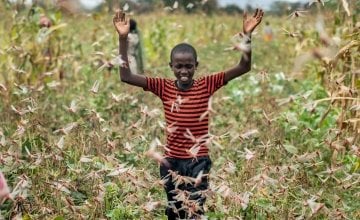
Knowledge Hub
Concern teams to assist communities impacted by locust swarms

Concern Worldwide’s teams on the ground in east Africa are gearing up to assist communities whose crops have been destroyed and whose pasturelands have been lost as a result of massive swarms of locusts which are eating everything in their path.
“As the swarms move through communities they eat everything green including leaves, crops and pasturelands,” Concern’s Acting Country Director in Somalia, Andrea Solomon, said. “Even the stalks from last year’s crop which farmers had stored to feed their animals during the dry season have been infested by the locusts.”
The locust swarms have caused extensive damage in southern areas of Somalia where they arrived shortly before the crops were due to be harvested. Considerable damage has been done to harvests of sorghum, cowpeas, groundnuts and maize. The locusts have also eaten seeds that would have been reserved for the next cropping season.
A swarm one kilometre square can contain up to 150 million locusts, which in a day can devour as much as 35,000 people could eat daily. Concern’s team is currently assessing the current situation and the scale of the impact made by the locusts to date in nine districts in Somalia.
“These are communities which are struggling to recover from repeated shocks,” Ms Solomon said. “They have come through long period of drought and food insecurity in 2017-18, followed by severe flash floods in late 2019, and now the locusts have arrived, all of which is compounded by high levels of insecurity and sporadic conflict.”
These communities face a precarious future, she warned: “The rains are due to arrive later in March and, if they perform well, people can hope for a good harvest, but good rains will also provide ideal conditions for the locusts to breed and thrive. If, on the other hand, the rains are poor, affected farmers can expect a poor harvest and another set of problems.”
Swarmed towards Somalia
The locusts were blown from Yemen in December and swarmed southwards through Somalia, laying their eggs as they moved. New locusts are already hatching and starting to swarm in coastal areas, with more swarms predicted in March and April.
Concern Somalia has established mechanisms in place that allow for the distributions of emergency cash transfers and will be able to utilise these as needed in response to the humanitarian impact of the locust crisis.
“If farmers have to move their livestock further away to graze due to the destruction caused by locusts, it will mean their children will have little access to milk, which from past experience can lead to increases in malnutrition rates and negative coping strategies such as children dropping out of school,” Ms Solomon said.
Meanwhile, further south in Kenya, locust swarms up to 60 km by 40 km are expected to result in harvest losses of 50% to 75% in some areas, and losses of up to 65% of pastureland. Concern is responding with cash supports for 5,000 people throughout April and May, in response to the worst locust infestation in Kenya in 75 years.
The UN’s Food and Agriculture Organisation (FAO) has warned that the number of locusts could be 500 times greater by June unless effective control measures are taken. The FAO and Kenyan government are working to spray infestations to control them.
With wind directions expected to change in March, the FAO is forecasting that the swarms will move northerly towards Ethiopia, Somalia, South Sudan and Sudan, putting food supplies of another 20 million vulnerable people at risk.
To donate visit www.concern.org.uk
For media queries contact Hannah Myerson, Senior Communications Officer, Concern Worldwide, at 0207 801 1046 or by emailing [email protected]
Our impact in 2024
people reached, in 27 of the world's most fragile places
people supported in 50 emergencies
people reached through our health and nutrition programmes
Other ways to help
Donate now
Give a one-off, or a monthly, donation today.
Join an event
From mountain trekking to marathon running, join us for one of our many exciting outdoor events!
Buy a gift
With an extensive range of alternative gifts, we have something to suit everybody.
Leave a gift in your will
Leave the world a better place with a life-changing legacy.
Become a corporate supporter
We partner with a range of organisations that share our passion and the results have been fantastic.
Create your own fundraising event
Raise money for Concern by organising your own charity fundraising event.


